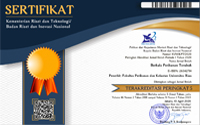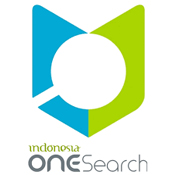Identification of Microplastics in Water Column at Koto Panjang Dam, Kampar Regency, Riau Province
Abstract
In PLTA Koto Panjang Dam, plastic waste comes from various community activities and fishery activities. The waste is destroyed into small particles (0.3-5mm) called microplastics. To determine the presence of microplastics in the water column, a study was conducted in December 2020 - February 2021. Water samples were taken from 3 stations with 3 sampling points at 3 different depths using Water Sampler. 250 ml of water was taken and filtered using a plankton net plankton no. 25. To obtain the microplastics, the filtered water was again filtered using Whatman filter paper No.42 and the type of microplastics were identified using a binocular microscope. The results of the study were found to be fiber, film and fragments. The abundance of microplastics ranged from 22 to 533.33 particles/m3. The highest total abundance is at station 3 with fiber type at a depth of 3 meters at 533.33 particles/m3. While the lowest abundance type is at station 1 with a film type at a depth of 6 m as many as 22 particles/m3.
Keywords
Full Text:
PDFReferences
Abdli, S., Toumi, H., Lahbib, Y., and Menif, N.T. 2017. The First Evaluation of Microplastics in Sediments from the Complex Lagoon-Channel of Bizerte (Northern Tunisia). Water Air Soil Pollut. 228:262. Almahdahulhizah, V. 2019. Analisis Kelimpahan dan Jenis Mikroplastik pada Air dan Sedimen di Sungai Wonorejo, Surabaya, Jawa Timur. Universitas Brawijaya.
Apridayanti E. 2008. Evaluasi Pengelolaan Lingkungan Perairan Waduk Lahor Kapubaten Malang Jawa Timur. Universitas Diponegoro (Tesis).
Ayun, N. Q. 2019. Analisis Mikroplastik Menggunakan Ft-Ir Pada Air, Sedimen, Dan Ikan Belanak (Mugil cephalus) Di Segmen Sungai Bengawan Solo Yang Melintasi Kabupaten Gresik. Skripsi, Surabaya.
Ayuningtyas W. C, D. Yona, S. H, Julinda, F. Iranawati. 2019. Kelimpahan Mikroplastik Pada Perairan Di Banyuurip, Gresik, Jawa Timur. Marine Resource Explore Management (MEXMA) Research Group, Fakultas Perikanan dan Ilmu Kelautan. Universitas Brawijaya, Malang. Journal of Fisheries and Marine Research. 3(1) 41-45.
Ballent, A., Purser, A., De Jesus Mendes, P.P., S., Thomsen, L., 2012. Physical Transport Properties of Marine Microplastic Pullution. Biogeosciences Discussions. 9(18755-18798).
Barnes, D. K. A., Galgani, F., Thompson, R. C., & Barlaz, M. 2009. Accumulation and fragmentation of plastic debris in global environments. Philosophical Transactions of the Royal Society B: Biological Sciences, 364: 1985–1998.
Boerger, C.M., G.L. Lattin, S.L. Moore, C.J. Moore. 2010. Plastic Ingestion by Planktivorous Fishes in the North Pacific Central Gyre. Mar. Poll. Bull., 60: 2275–2278.
Bouwmeester, H., Hollman, P.C.H., Peters, R.J.B. 2015. Potential Health Impact of Environmentally Released Micro and Nanoplastics in the Human Food Production Chain: Experiences From Nanotoxicology. Environmental Science & Technology.
Browne, M.A., Crump, P., Niven, S.J., Teuten, E., Tonkin, A., Galloway, T., Thompson, R. 2011. Accumulation of microplastic on shorelines woldwide: sources and sinks. Environ. Sci. Technol. 45:9175-9179.
Carson H. S, M. S. Nerheim, K. A. Carroll, M. Eriksen. 2013. The Plastic-Associated Microorganisms of The North Pacific Gyre. Marine Pollution Bulletin. 75: 126 –132.Cauwenberghe, L.V., Vanreusel, A., Mees, J., Janssen, C.R. 2013. Microplastic pollution in deep-sea sediments. Environ. Pollut. 182, 495–499.
Coppock, R. L., Cole, M., Lindeque, P. K., Queirós, A. M., & Galloway, T. S. 2017. A Small-Scale, Portable Method for Extracting Microplastics from Marine Sediments. Environmental Pollution, 230: 829–837.
Dewi, I. S., Budiarsa, A. A., & Ritonga, I. R. 2015. Distribusi mikroplastik pada sedimen di Muara Badak , Kabupaten Kutai Kartanegara. Depik, 4(3): 121–131.
Effendi, H. 2003. Telaah kualitas air, bagi pengelolaan sumber daya dan lingkungan perairan. Kanisius.Yogyakarta.
Effendi, H., Utomo, B. A., Darmawangsa, G. M., & Karo-karo, R. E. 2015. Fitoremediasi Limbah Budidaya Ikan Lele (Clarias sp.) dengan Kangkung (Ipomoea aquatica) dan Pakcoy (Brassica rapa chinensis) dalam Sistem Resirkulasi. Ecolab, 9(2): 80–92.
Eriksen, M., Mason, S., Wilson, S., Box, C., Zellers, A., Edwards, W., Farley, H., & Amato, S. 2013. Microplastic pollution in the surface waters of the Laurentian Great Lakes. Marine Pollution Bulletin, 77(1–2):177–182.
Estahbanati, S., Fahrenfeld, N. L. 2016. Influence of Wastewater Treatment Plant Discharges on Microplastic Concentrations in Surface Water. Chemosphere, 162:277-284.
Fatimah, N., Bambang, Widigdo., Taryono. 2019. Komposisi dan Kelimpahan Makroplastik dan Mikroplastik pada Air di Muara Sungai Citarum, Kabupaten Bekasi, Jawa Barat. IPB Repository. Bogor.
Fischer, E.K., Paglialonga, L., Czech, E., Tamminga, M., 2016. Microplastic pollution in lakes and lake shoreline sediments e a case study on Lake Bolsena and Lake Chiusi (Central Italy). Environ. Pollut. 213, 648e657.
Galgani, F. 2015. The Mediterranean Sea: From litter to microplastics. Micro 2015: Book of abstracts.
Harpah, N., Suryati, I., Leonardo, R., Risky, A., Ageng, P., Addauwiyah, R. 2020. Analisa Jenis, Bentuk dan Kelimpahan Mikroplastik di Sungai Sei Sikambing Medan. Jurnal Sains dan Teknologi. 20(2): 108-115.
Haryanto H, Thamrin, dan Sukendi. 2013. Status Trofikdan Daya Tampung Beban Pencemaran Air Limbah Budi daya Ikan KJA Di Waduk Koto Panjang. (Tesis). Pekanbaru. Universitas Riau.
Hiwari, H., Purba, N. P., Ihsan, Y. N., Yuliadi, L. P. S., & Mulyani, P. G. 2019. Kondisi sampah mikroplastik di permukaan air laut sekitar Kupang dan Rote, Provinsi Nusa Tenggara Timur. Prosiding Seminar Nasional Masyarakat Dan Biodiversitas Indonesia, 5(2): 165–171.
Horvat, Pieter, M. Kunaver, A. Krzan. 2015. Techniques Usefull for Characterization of Microplastics. Proceedings of the Micro 2015.
Jambeck J. R, Geyer R, Wilcox C, Siegler T.R, Perryman M, Andrady A dan Narayan Junaidi. 2015. Statistik Uji Kruskal Wallis. Jambi. Fakultas Ekonomi Universitas Jambi.
Katsanevakis SA, Katsarou. 2004. Influences on the Distribution of Marine Debris on the Seafloor of Shallow Coastal Areas in Greece (Eastern Mediterranean). Water, Air, and Soil Pollution. 159:325-337.
Krismono, A. Samita dan, A. Rukyani. 1996. 1600 Ton Ikan Mati di Waduk Jatiluhur. Warta Penelitian Perikanan Indonesia. Pusat Penelitian dan Pengembangan Perikanan. Jakarta. 1(1): 5.
Laforsch, C. 2015. Microplastics in freshwater ecosystems. Seminar on Microplastics Issues: Book of abstracts.
Lattin, G.L., Moore, C.J., Zellers, A.F., Moore, S.L., Weisberg, S.B., 2004. A comparison of neustonic plastic and zooplankton at different depths near the southern California shore. Mar. Pollut. Bull. 49, 291–294.
Lippiat S, Opffer S, Arthur C. 2013. Marine Debris and Monitoring Assessment. NOAA.
Manalu A. 2017. Kelimpahan Mikroplastik di teluk Jakarta. Tesis. Sekolah Pascasarjana IPB.
Mani, T., Hauk, A., Walter, U., Burkhaidi-Holm, P. 2015. Microplastics Profile along the Rhaini River. Scientific Reports. 5:1-7.
Mauludy, M. S., Yunanto, A., & Yona, D. 2019. Microplastic Abundances in the Sediment of Coastal Beaches in Badung, Bali. Jurnal Perikanan Universitas Gadjah Mada, 21(2): 73–78.
Mu J, Zhang S, Qu L, Jin F, Fang C, Ma X, Zhang W, Wang J. 2019. Microplastics abundance and characteristics in surface waters from the Northwest Pacific, the Bering Sea, and the Chukchi Sea. Mar. Pollut. Bull. 143:58-65.
Nastiti, A. S., Krismono, dan E.S. Kaftamihardja. 2007. Dampak Budi Daya Ikan Dalam Keramba Jaring Apungterhadap Peningk,Atan Unsur N Dan P Di Perairan Waduksaguling, Girata, Dan Jatiluhur. Jumal Penelitian Perikanan lndonesia. 7(2): 22-30.
NOAA (National Oceanic and Atmospheric Administration). 2018. What is marie debris. https://marinedebris.noaa.gov/discover-issue. Di akses tanggal 26 Oktober 2020.
PLN, 2014. PLTA Kota Panjang 114 MW. Https://Pltakotapanjang.Wordpress.Com/. Diakses pada 03 Juni 2021 pukul 15.14 WIB.
Rahman A. 2010. Penentuan Status Trofik Waduk PLTA Koto Panjang Provinsi Riau Berdasarkan Kandungan Klorofil-A dan Beberapa Parameter Lingkungan. [Skripsi]. Institut Pertanian Bogor. Bogor.
Roha-Sabtos, T, A. P., Duarte, A. C. 2017. Comprehensive Analytical Chemistry: Characterization and Analysis of Microplastics. Elsevier, New York.
Sembiring, H. 2008. Keanekaragaman dan distribusi udang serta kaitannya dengan faktor fisik kimia di perairan pantai Labu Kabupaten Deli Serdang. Sekolah Pascasarjana, Universitas Sumatera Utara. Medan.
Septian, F. M., Purba, N. P., Agung, M. U. ., Yuliadi, L. P. ., Akuan, L. F., & Mulyani, P. G. 2018. Sebaran Spasial Mikroplastik di Sedimen Pantai Pangandaran, Jawa Barat. Jurnal Geomaritim Indonesia, 1(1):1–8.
Simarmata, A.H. Siagian. M dan Sihotang, C. 2013. Pengelolaan Waduk Koto Panjang yang Berkelanjutan Berdasarkan Status Trofik dan Beban Perairan. Laporan Penelitian Unggulan Perguruan Tingggi. Lemlit. Univ. Riau Pekanbaru.
Su, L., Xue, Y., Li, L., Yang, D., Kolandhasamy, P., Li, D., Shi, H. 2016. Microplastics in Taihu Lake, China. Environmental Pollution. 216:711-719.
Sumiarsih, E. 2014. Dampak Limbah Kegiatan Keramba Jaring Apung (KJA) terhadap Karakteristik Biologi Ikan Endemik di Sekitar PLTA Koto Panjan, Riau.Disertasi.Program Pasca Sarjana Universitas Padjajaran. Bandung. (Tidak diterbitkan).
Sumiarsih, E., Djunaedi, O. S., Dhahiyat, Y., & Zahidah, Z. 2015. Hubungan Antara Karamba Jaring Apung dengan Jenis Makanan yang terdapat pada Lambung Ikan Endemik di Waduk Koto Panjang, Riau. In Indonesian Journal of Applied Sciences. 5(1):45-48.
Suparjo, M. N. 2009. Kondisi Pencemaran Perairan Sungai Babon Semarang. Jurnal Saintek Perikanan, 4(2):38–45.
Syachbudi, R. R. 2020. Identifikasi Keberadaan dan Bentuk Mikroplastik pada Sedimen dan Ikan di Sungai Code, D.I Yogyakarta. Program Studi Teknik Lingkungan, UII, Yogyakarta.
Tafangeyasha C, dan T. Dzinomwa . 2005. Land use Impacts on River Water Quality in Lowveld Sand River Systems in South-East Zimbabwe. Land Use and Water Resources Research. 5(3): 310.
Teuten, E. L., Rowland, S. J., Galloway, T. S., & Thompson, R. C. 2007. Potential for Plastics to Transport Hydrophobic Contaminants. Environmental Science & Technology, 41(22): 7759–7764.
Vaughan, R., Turner, S. D., & Rose, N. L. 2017. Microplastics in the sediments of a UK urban lake. Environmental Pollution, 229:10–18.
Virsek, M.K., Palatinus, A., Koren, S., Peterlin, M., Horvat, P., Krzan, A. 2016. Protocol for Microplastics Sampling on the Sea Surface and Sample Analysis. J. Vis. Exp. (118) : 1-9.
Widinarko dan Inneke. 2018. Mikroplastik dalam seafood dari pantai Utara Jawa. Unika. Semarang. Soegijapranata.
Wijaya, B. A., Trihadiningrum, Y. 2019. “Pencemaran meso- dan mikroplastik di Kali Surabaya pada Segmen Driyorejo hingga Karang Pilang”. Jurnal Teknik ITS. 8(2):2–7.
Wright, S.L., Thompson, R.C., Galloway, T.S., 2013. The physical impacts of microplasticson marine organisms: a review. Environ. Pollut. 178, 483–492.
Xiong, X., Wu, C., Elser, J. J., Mei, Z., Hao, Y. 2019. Occurrence and Fate of Microplastic Debris Inmiddle and Lower Reaches of the Yangtze River – From Inland to the Sea. Science of the Total Environment. 659:66-73.
Zhang, W., S. Zhang, J. Wang, Y. Wang, J. Mu, P. Wang, X. Lin, D. Ma. 2017. Microplastic Pollution in the Surface Waters of the Bohai Sea, China. Evironmental Pollution. 231: 541-548
Zidni, I., Afrianto, E., Mahdiana, I., Herawati, H., & Bangkit, I. 2018. Laju Pengosongan Lmbung Ikan Mas (Cyprinus carpio) dan Ikan Nila (Oreochromis niloticus). Jurnal Perikanan Dan Kelautan, 9(2):147–151.
Zhu L, Bai H, Chen B, Sun X, Qu K, Xia B. 2018. Microplastic pollution in North Yellow Sea, China: Observations on occurrence, distribution and identification. Science of The Total Environment. 636:20-29.
DOI: http://dx.doi.org/10.31258/terubuk.49.3.1353-1362
Refbacks
- There are currently no refbacks.
Copyright (c) 2022 Muhammad Edy, Budijono Budijono, Muhammad Hasbi

This work is licensed under a Creative Commons Attribution 4.0 International License.












